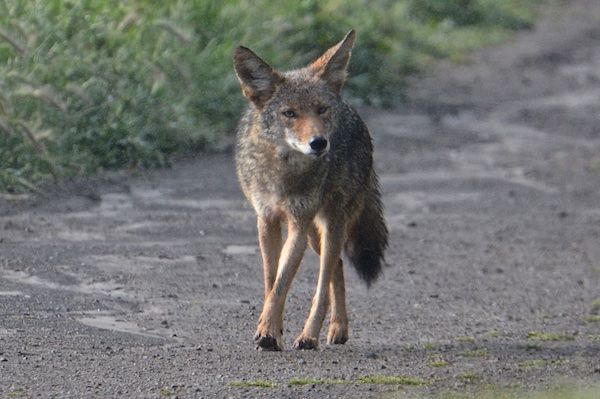Then, about 5-6 months ago, I was in that same area with my dog, turned a corner and saw a coyote right next to the trail. I remembered what the guy had said, so I just stood at a distance and waited and hoped the coyote would leave. My dog stood at my side, not saying anything but watching. The coyote turned its head to the side, and another coyote trotted out. Then the first coyote looked straight at us and stomped its feet. I took that as our cue to leave.
I have learned that you aren’t supposed to turn your back on a coyote, so I backed away, pulling my dog with me. It was a narrow trail and my dog didn’t exactly want to back off, so this was not the easiest. The coyotes kept coming towards us, and I kept backing away, keeping my dog right by my feet. They didn’t seem afraid at all, but when I shouted at them, they stopped. They followed us on the trail all the way to the main road that goes up the hill, probably 10-15 minutes. Then they veered off.

Coyote at Windy Hill by Don Owens, licensed under CC BY 2.0 (2015)
Since then I’ve seen some at a distance, but not right on the trail. At least until this morning.
About halfway up the main road (Spring Ridge Trail), I saw two coyotes on the edge of the road. I stopped (with my dog), and waited. They slowly came toward us, and my dog started to get agitated. I yelled at them, but it didn’t seem to have an effect. One went behind us and one stayed in front of us, which made it more difficult for me to diffuse. Fortunately a biker came by just then and the coyotes trotted off. My dog calmed down and up we went.
On the way down, we saw them again, grazing on the grass right next to the road. I stopped far up the trail and made sure my dog was quiet. We just stayed and watched. Slowly one started to approach, then the other. I pulled my dog behind me, since I had begun suspecting she might be the problem and I didn’t want her staring at them. That seemed to help some. Instead of yelling at the coyotes, I talked to them in a calm voice and tried to reassure my now quivering dog. Eventually they ambled off of the road.
I thought this was blog-worthy for a few reasons (besides the fact that I hadn’t written my sometimes-weekly blog post yet)...
I wonder what is emboldening the coyotes. Is it just that there are more people (and dogs) on the trails and the coyotes have gotten used to them? I hope that people are not feeding the coyotes. I hope that people are staying on the trail, leaving the coyotes a safe habitat in which to raise their pups. I do sometimes see dogs off-leash at Windy Hill, often trailing after a jogger. Those dogs look pretty compliant as they follow along on the trail, but if they do go off-trail, I can see why the coyotes would get pretty upset.
These incidents reinforced to me how important it is to not feed the wildlife and to stay on the trails. We want the wildlife to stay wild and to have safe spaces.
In Tahoe we see bears, coyotes, and increasingly mountain lions becoming bolder and more habituated to people. As we encroach more into their territory, they are coming down to the lake more and interacting with people (and their pets). The trail system in Tahoe gets built out more each year, and with more people comes more activity. E-bikes may soon be allowed on trails, allowing even more people to go even farther into the wilderness. At what point do we stop? Each year there is less quiet space for wildlife to feel safe foraging and raising their young.
I worry about the effects of so many people enjoying the wilderness coupled with the erosion of habitat due to climate change. We talk a lot about the effect of climate change on people, but at least people have some ability to quickly adapt. We can move across the country (or the planet) to more habitable places, we can install fans and air conditioners, we can route water to where we need it, at least to some degree. But animals cannot do any of this. I keep meaning to do a blog post on extinction, but it’s too depressing. For now, I’d love to hear your thoughts on how, or whether, we can achieve balance when it comes to the other inhabitants of our natural world, especially as we all face increasing pressures from climate change.
Notes and References
1. Live Science has some general information about coyotes.
Current Climate Data (April 2021)
Global impacts, US impacts, CO2 metric, Climate dashboard (updated annually)
Comment Guidelines
I hope that your contributions will be an important part of this blog. To keep the discussion productive, please adhere to these guidelines or your comment may be moderated:
- Avoid disrespectful, disparaging, snide, angry, or ad hominem comments.
- Stay fact-based and refer to reputable sources.
- Stay on topic.
- In general, maintain this as a welcoming space for all readers.



